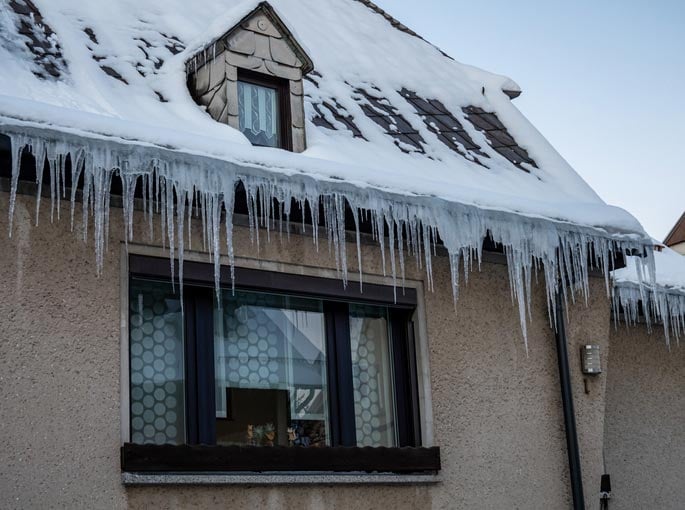
Winter may be the toughest season on our homes and properties, and there may be no part more affected than our home’s roof.
While our home’s landscaping has to endure the changing temperatures, too, it’s the potential for problems connected to the roof that keeps us homeowners up at night.
Unfortunately, those problems, including snow and ice buildup, aren’t going to be resolved by waiting until spring.
To help you stay on top of your roof’s health, we’ve prepared a list of five of the most common winter roof damage issues and tips on handling them. By staying on top of your winter roof damage watch now, you’ll be better prepared no matter what kind of weather we’re dealing with.
1. Ice Dams
One of the principal problems homeowners deal with when it comes to winter roof damage are ice dams. These result when warm air rises up from your home up to the roof’s shingles. There, it melts the snow on the shingles, which then drips to colder areas of the roof’s edges.
At that point, the snow freezes again. Only this time, it becomes ice. Once that ice becomes too thick, additional snowmelt backs up behind it and goes underneath the shingles. At this point, when the snow melts, it enters your home through leaks. Then if that backed-up water freezes and thaws, it can expand in crevices and cracks in your home, exacerbating the leaks even further.
Insulating and ventilating your attic is the best way to avoid an ice dam. In the fall, you can reduce your risk by clearing out your gutters and downspouts. When it starts to snow, use a roof rake to remove snow from the corners of your roof. Another tactic is to put heat trace cables in the gutters to keep the snow melting and to avoid blockages.
2. Icicles
The same conditions that lead to ice dams can also produce icicles.
While icicles are sometimes thought of as a charming side effect of winter weather, they have some serious downsides. Not only can they ruin gutters and roofs, they can shatter and fall on people below.
Icicles and ice dams can both be reduced with the elimination of roof-top air leaks and by improving insulation.
For a more hands-on approach, you can also remove icicles with a long-handled roof rake or by climbing up a ladder close to them and removing them. As a note of caution, you should never climb a ladder that is on ice or that has loose feet, and never step onto an icy roof.
3. Attic Condensation
If you’ve started to see some of the signs above, it’s likely you are also going to be dealing with attic condensation.
In addition to the potential for damage that comes from water freezing and unfreezing, the accumulation of moisture can cause mold and wood damage.
To avoid attic condensation, aim for proper ventilation. To do so, it's essential to seal any insulation gaps in the attic floor where wet air from below could seep in.
Given that broken plumbing, dehumidifiers, and other equipment can lead to an accumulation of extra moisture, it’s also important to monitor their conditions throughout the year.
4. Heavy Snow Loads On Roof
While snow piling up on the roof may have its seasonal charms, it is one of the leading causes of winter roof damage.
What homeowners may be surprised to find out is that certain roofs are made to support certain weight loads. If too much ice and snow build up on top of the roof, there’s a real risk of the roof collapsing.
Massive drifts of lighter snow can apply significant forces, yet it’s wet snow that is particularly heavy. Sometimes, poor roof structure and/or drainage can make the problem worse and result in an overstressed roof that starts to creak, leak, and cause drooping ceilings.
When you notice or hear the warning signs, contact a roofing expert immediately because this is a dangerous condition.
5. Exacerbating Existing Problems
If you’re on winter roof damage watch, one of the worst things you can do is think that your roof’s current problems won’t be affected.
For roofs that are dealing with wobbly shingles, unsecured roof flashings, or gutter seams with already broken caulking, winter weather will only make them worse. With the snow load and the cycling between freezing and thawing, many of these small problems will only get worse.
If you’ve seen signs of these weaknesses or are worried about your roof standing up to the winter weather, it’s valuable to get a roof inspection and any necessary repairs done as soon as possible.
Ensuring Your Roof Is Well Taken Care Of
No homeowner’s roof is immune to these five winter roof damage issues. At the minimum, preventing roof damage requires being aware of your roof’s condition. It can also take investments to care for your roof before, during, and after harsh weather.
If you find yourself needing to contact your insurance to make roof repairs after one of these storms, US Home Supplements can help. Insurance carriers may require additional information for repairs and restoration projects.
At US Home Supplements, we’ve supplemented thousands of projects and we’re here to help make sure your job is done right. Contact us today for more information.
What You Need To Know About Roofing Claim Supplements in South Carolina
Are you a roofing contractor in South Carolina gearing up for another season of helping homeowners replace their roofs?
You don’t need us to tell...
How Insurance Claim Supplements in Dallas Help Protect Roofs and Homes
When it comes to roofing in Dallas, there's no doubt that the city's diverse weather can take a toll on your city’s roofs.
From scorching summers...
